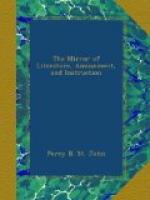“The carcass that you look at so,
Is not Sam Deacon, you must know,
But ’tis the carriage—the machine,
Which Samuel Deacon rideth in.”
* * * * *
ADVANTAGES OF LOQUACITY
A very pretty woman, who was tediously loquacious, complained one day to Madame de Sevigne, that she was sadly tormented by her lovers. “Oh, Madame,” said Madame de Sevigne to her, with a smile, “it is very easy to get rid of them: you have only to speak.”
* * * * *
Printed and Published by J. LIMBIRD 143, Strand, (near Somerset House,) London; sold by ERNEST FLEISCHEN, 626, New Market, Leipsic; and by all Newsman and Booksellers.
FOOTNOTES:
[1] The old bridge was of wood, and 168 yards in length. It was the most ancient on the River Thames, except that of London, and is mentioned in a record of the 8th year of Henry III.
[2] At the time the chapel fell, the sexton, while digging a grave was buried under the ruins, with another person, and his daughter. The latter, notwithstanding she lay covered seven hours, survived this misfortune seventeen years, and was her father’s successor. The memory of this event is preserved by a print of this singular woman, engraved by M’Ardell.
[3] The work is dedicated to Dr. Babington, “in remembrance of some delightful days passed in his society, and in gratitude for an uninterrupted friendship of a quarter of a century;” and in the preface the author, after saying that the characters are imaginary, intimates that “in the portrait of HALIEUS, given in the last dialogue, a likeness, he thinks, will not fail to be recognised to that of a most estimable physician, ardently beloved by his friends, and esteemed and venerated by the public.”
[4] In our last volume, this was erroneously attributed to Swift.
[5] See page 370, vol. xi. MIRROR.
[6] As “kill him, crimp him,” &c.
[[7]] The late worthy and scientific Wm. Reynolds, of the Bank, near Ketley.
[8] M. Huber was the father of the author of a work on the economy of bees, and the grandfather of the author of a work on the economy of ants. The first M. Huber had a very peculiar talent for drawing; with his scissors he could cut a piece of paper into a representation of anything, as accurately, and as fast, and with as much spirit, as he might have delineated with his pencil either figures or landscapes. Voltaire was his favourite subject; and he is known to have taught his dog to bite off a piece of crumb of bread, which he held in his hand, so as to give it as last the appearance of Voltaire.



